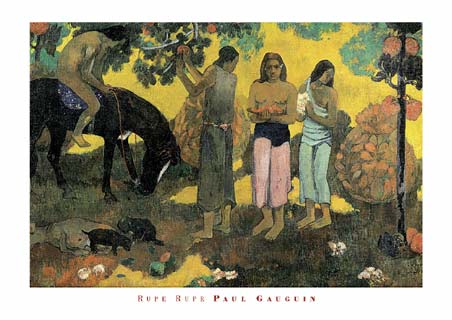
Oil on canvas, 37 x 28 1/2 in. (94 x 72.4 cm)
Gift of William Church Osborn, 1949
Met museum 49.58.1
 Oil on canvas, 37 x 28 1/2 in. (94 x 72.4 cm) Gift of William Church Osborn, 1949 Met museum 49.58.1 |
|
(From info card) "Before Gauguin brought his work in Tahiti to a close, he shifted from his symbolist pictorial agenda in order to focus on the beauty and serene virtues of the native women. In this painting, he depended on sculpturally modeled forms, gesture, and facial expression to vivify the sentiments he had used to describe the "Tahitian Eve": "very subtle, very knowing in her na´vetÚ" and at the same time "still capable of walking around naked without shame." These two figures first appear in the artist's monumental frieze "Faa Iheihe (Tahitian Pastoral)" of 1898 (Tate, London) and again in the even larger "Rupe, Rupe" of 1899 (Pushkin Museum of Fine Arts, Moscow), which he composed for the upcoming Exposition Universelle of 1900."
 From a print of a cropped detail of "Rupe, Rupe" Compared to the image at Wikipedia, it appears to have been flipped, but the color seems truer, less yellowed.
|


